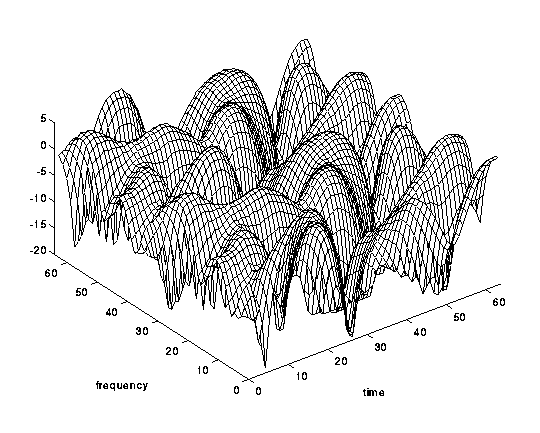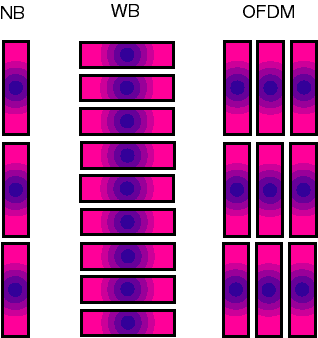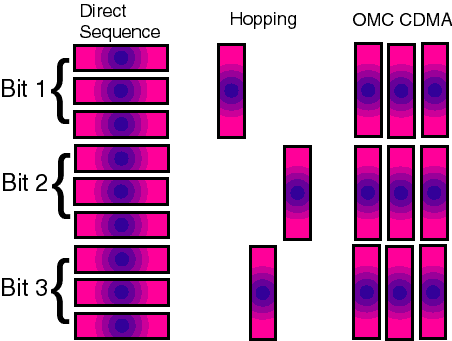
 |
JPL's Wireless Communication Reference WebsiteChapter: Analog and Digital Transmission |

Some basics about modulation: ppt
Example of popular narrowband modulation methods are
What Modulation Suits the Channel?
 Multipath reception and user mobility lead to channel behavior that is time and
frequency dependent. In the following frequency-time diagrams, we depict where
in frequency and when in time most of the bit energy is located. It is important
to select a modulation scheme that is appropriate for the Doppler
spread and the delay spread
of the channel. It is seen from the channel scatter
function or from samples of the channel
that:
Multipath reception and user mobility lead to channel behavior that is time and
frequency dependent. In the following frequency-time diagrams, we depict where
in frequency and when in time most of the bit energy is located. It is important
to select a modulation scheme that is appropriate for the Doppler
spread and the delay spread
of the channel. It is seen from the channel scatter
function or from samples of the channel
that:

| In narrowband communication (NB), the occupied bandwidth is small
and the bit duration is long. The bit energy footprint is stretched in vertical direction.
Intersymbol interference is neglectable is the bit duration is, say, ten times or more longer than the
delay spread. However, due to multipath the entire signal (bandwidth) may vanish
in a deep fade. Is fading is very fast, the channel may change during a bit transmission.
This can occur if the Doppler spread is large compared to the transmit bandwidth.
In wideband transmission (WB), i.e., transmission at high bit rate, the signal is unlikely to vanish completely in a deep fade, because its bandwidth is so wide that some components will be present at frequencies where the channel is good. Such frequency selective fading, however, leads to intersymbol interference, which must be handled, for instance by an adaptive equalizer. In OFDM or multicarrier systems, multiple bits are transmitted in parallel over multiple subcarriers. If one subcarrier is in a fade, the other may not. Error correction coding can be used to correct bit errors on faded subcarriers. Rapid fading (Doppler) may erode the orthogonality of closely spaced subcarriers. |

|
In the above frequency-time plot, every tile represents one bit. In spread-spectrum transmission one bit is often transmitted in multiple 'chips'. Below, one such chip is plotted as a tile. One bit is spread over multiple tiles.
|
Direct sequence intentionally broadens the transmit spectrum by multiplying user bits with a fast random sequence.
The wideband signal is unlikely to
fade completely. If frequency selective fading occurs, the receiver sees a series of
time-shifted versions of the chipped bit. A rake receiver can separate
the individual resolvable paths.
Frequency hopping. The carrier frequency is shifted frequently, to avoid fades or narrowband interference. While the signal may vanish during one hop to a particular frequency, mostly likely other hops are to frequencies at which the channel is good. Error correction is applied to correct bits lost at faded frequencies. Slow and fast hopping methods differ in the relative duration spent at one frequency, compared to the user bit duration.
Orthogonal multicarrier spread spectrum
is a spectrum-spreading method to exploits advantages of OFDM and DS-CDMA.
each user bit is transmitted simultaneously and in parallel over multiple subcarriers.
This corresponds to a 90 degree rotation of a bit energy map in the frequency-time plane.
|
 
|
 | PDF Slides on BPSK |